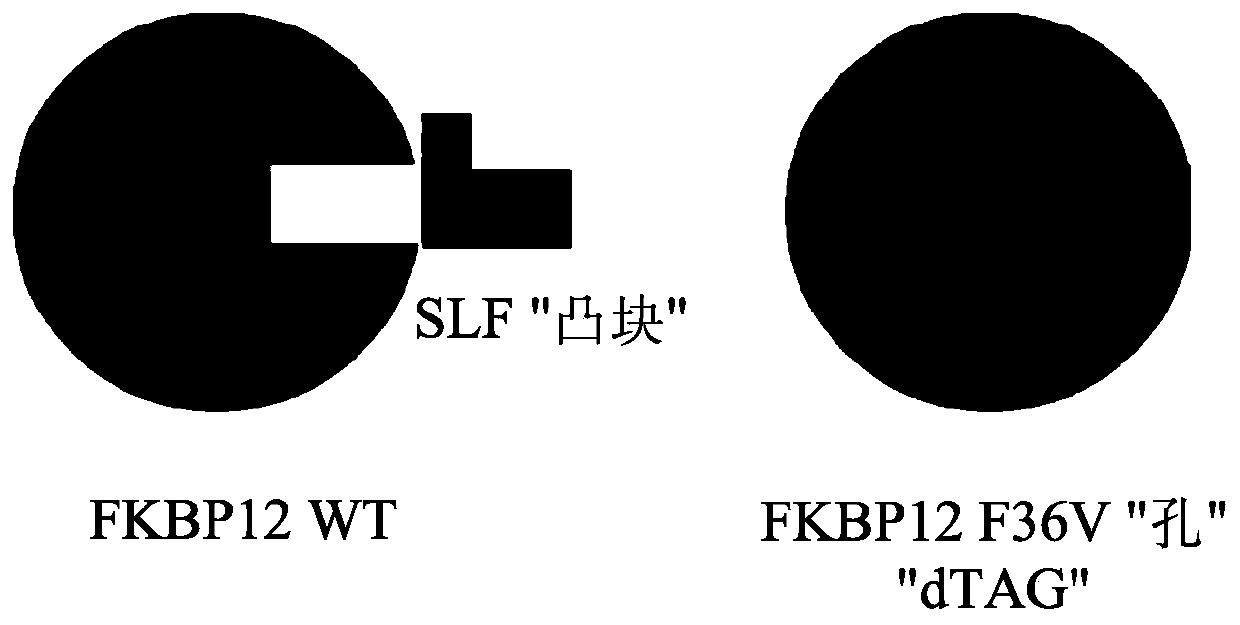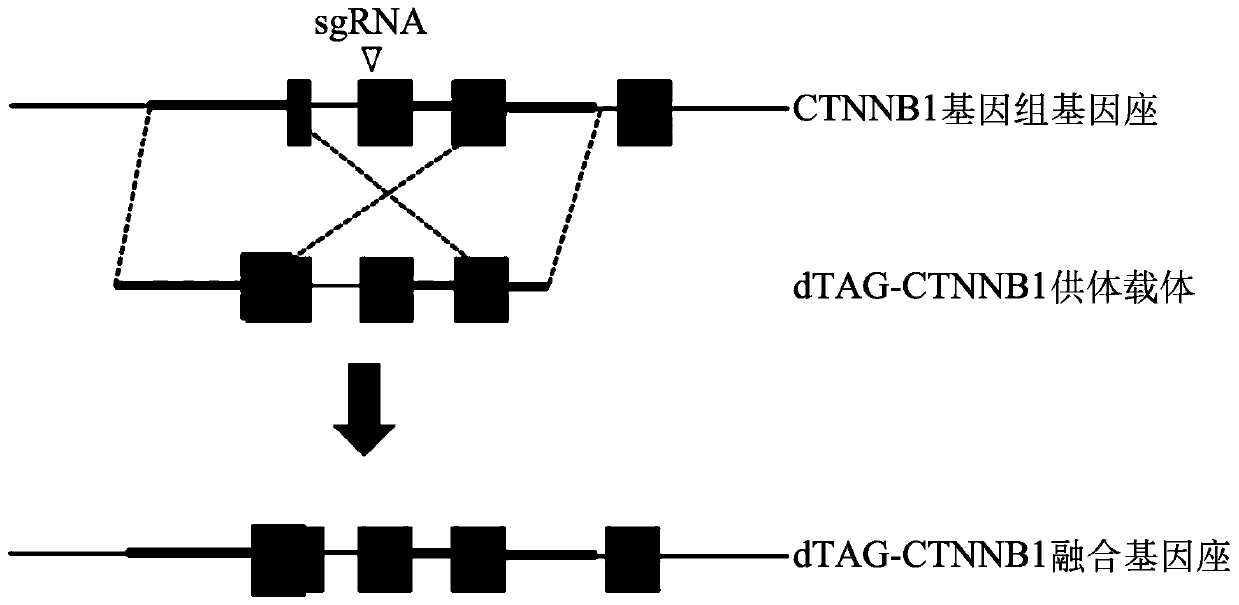Tunable endogenous protein degradation with heterobifunctional compounds
A functional and compound technology, applied in the direction of peptide/protein composition, genetic material composition, fusion with degradation motifs, etc., can solve problems such as infeasible regulation strategies in vivo
- Summary
- Abstract
- Description
- Claims
- Application Information
AI Technical Summary
Problems solved by technology
Method used
Image
Examples
Synthetic example 1
[1639] Synthesis Example 1: Synthesis of dBET1
[1640]
[1641] (1) Synthesis of JQ-acid
[1642] JQ1 (1.0 g, 2.19 mmol, 1 equiv) was dissolved in formic acid (11 mL, 0.2M) at room temperature and stirred for 75 hours. The mixture was concentrated under reduced pressure to give a yellow solid (0.99 g, quantitative yield), which was used without purification. 1 H NMR (400MHz, methanol-d 4 )δ7.50 –7.36(m,4H),4.59(t,J=7.1Hz,1H),3.51(d,J=7.1Hz,2H),2.70(s,3H),2.45(s,3H), 1.71 (s,3H). LCMS 401.33 (M+H).
[1643] N-(4-aminobutyl)-2-((2-(2,6-dioxopiperidin-3-yl)-1,3-oxoisoindoline-4 was synthesized according to a previously published method -yl)oxy)acetamide trifluoroacetate (Fischer et al., Nature 512(2014):49).
[1644] (2) Synthesis of dBET1
[1645] At room temperature, JQ-acid (11.3 mg, 0.0281 mmol, 1 eq) and N-(4-aminobutyl)-2-((2-(2,6-dioxopiperidin-3-yl)- 1,3-Oxoisoindolin-4-yl)oxy)acetamide trifluoroacetate (14.5 mg, 0.0281 mmol, 1 equiv) was dissolved in DMF (0.28...
Synthetic example 2
[1646] Synthesis Example 2: Synthesis of dBET4
[1647]
[1648]At room temperature, 0.1M N-(4-aminobutyl)-2-((2-(2,6-dioxopiperidin-3-yl)-1,3-oxoisoindoline-4 A solution of -yl)oxy)acetamide trifluoroacetate in DMF (0.438 mL) was added to (R)-JQ-acid (prepared from (R)-JQ1 in a similar manner to JQ-acid) (14.63 mg, 0.0365mmol, 1 equiv) 0.0438mmol 1.2 equiv). DIPEA (19.1 μL, 0.1095 mmol, 3 eq) and HATU (15.3 mg, 0.0402 mmol, 1.1 eq) were added and the mixture was stirred for 24 h, then diluted with MeOH and concentrated under reduced pressure. The crude material was purified by preparative HPLC to give a yellow solid (20.64 mg, 0.0263 mmol, 72%). 1 H NMR (400MHz, methanol-d 4 )δ 7.79(dd, J=8.4,7.4Hz,1H),7.51(d,J=7.3Hz,1H),7.47–7.39 (m,5H),5.11–5.06(m,1H),4.75(s, 2H),4.68(dd,J=8.8,5.5Hz,1H),3.47–3.31(m,5H),2.83–2.65(m,7H),2.44(s,3H),2.13–2.06(m,1H) ,1.68(s,3H),1.67–1.60(m,4H). 13 C NMR (100MHz, cd 3 od)δ174.43,172.40,171.29,169.92,168.24,167.82,166.71, 156.31,153.14,1...
Synthetic example 3
[1649] Synthesis Example 3: Synthesis of dBET3
[1650]
[1651] At room temperature, 0.1M N-(2-aminoethyl)-2-((2-(2,6-dioxopiperidin-3-yl)-1,3-oxoisoindoline-4 A solution of -yl)oxy)acetamide trifluoroacetate in DMF (0.475 mL, 0.0475 mmol, 1.2 equiv) was added to Q-acid (15.86 mg, 0.0396 mmol, 1 equiv). Then DIPEA (20.7 μL, 0.1188 mmol, 3 equiv) and HATU (16.5 mg, 0.0435 mmol, 1.1 equiv) were added and the mixture was stirred for 24 h before purification by preparative HPLC to give a yellow solid (22.14 mg, 0.0292 mmol, 74%). 1 H NMR (400MHz, methanol-d 4 )δ7.82–7.75(m,1H),7.52–7.32(m,6H),5.04(dd,J=11.6,5.5Hz,1H),4.76(d,J=3.2Hz,2H),4.66(d ,J=6.6Hz,1H),3.58–3.35(m,6H),2.78–2.58(m,6H),2.48–2.41(m,3H),2.11–2.02(m,1H),1.70(d,J = 11.8 Hz, 3H). 13 C NMR (100MHz, cd 3 od)δ174.38,171.26,171.19, 170.26,168.86,168.21,167.76,166.72,156.27,153.14,138.44, 138.36,138.19,134.87,133.71,132.31,131.57,131.51,129.90, 129.86,121.81,119.36,117.95,69.48, 54.83, 50.52, 40.09, 39.76, 38.30...
PUM
 Login to View More
Login to View More Abstract
Description
Claims
Application Information
 Login to View More
Login to View More - R&D
- Intellectual Property
- Life Sciences
- Materials
- Tech Scout
- Unparalleled Data Quality
- Higher Quality Content
- 60% Fewer Hallucinations
Browse by: Latest US Patents, China's latest patents, Technical Efficacy Thesaurus, Application Domain, Technology Topic, Popular Technical Reports.
© 2025 PatSnap. All rights reserved.Legal|Privacy policy|Modern Slavery Act Transparency Statement|Sitemap|About US| Contact US: help@patsnap.com



